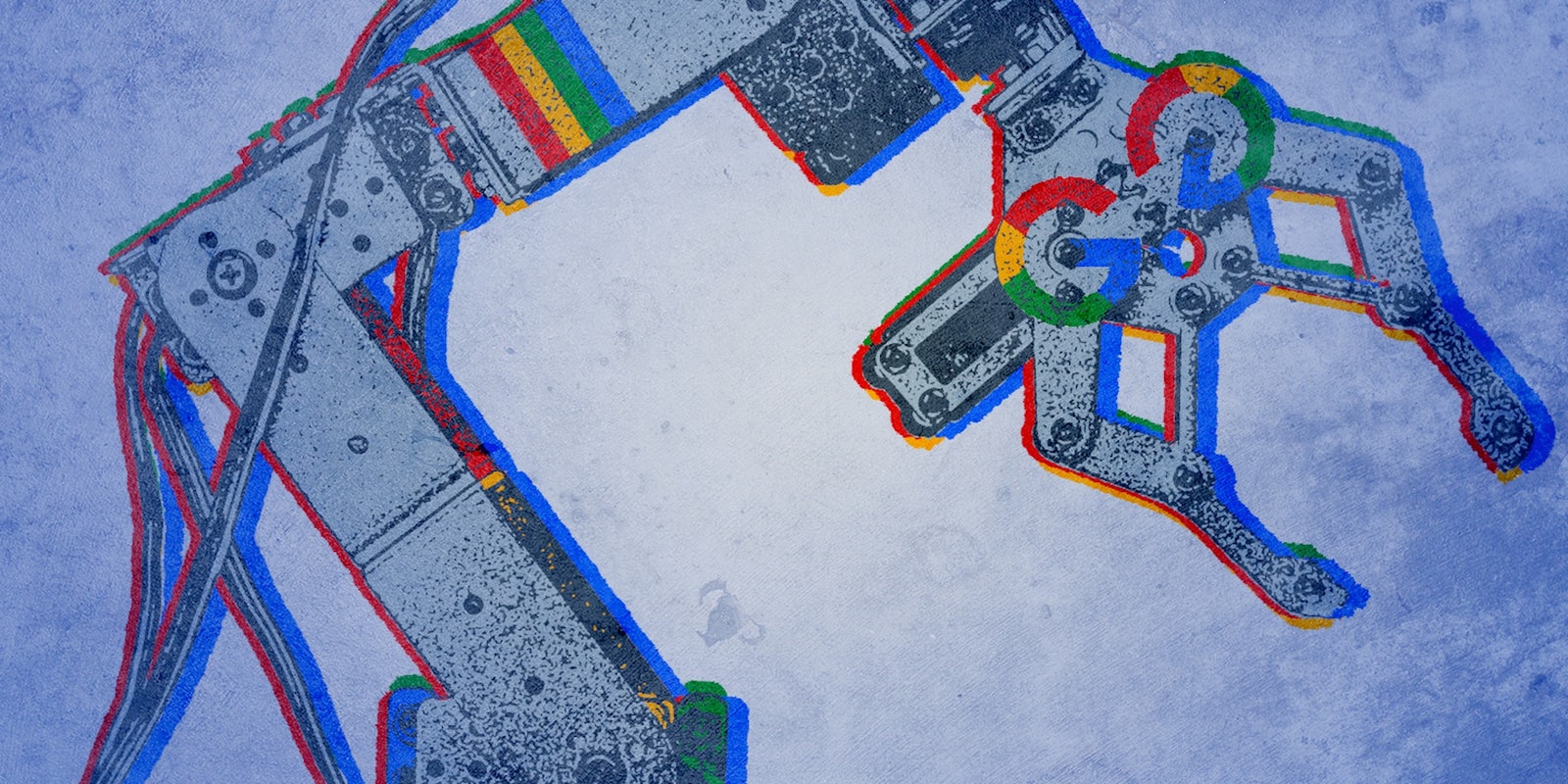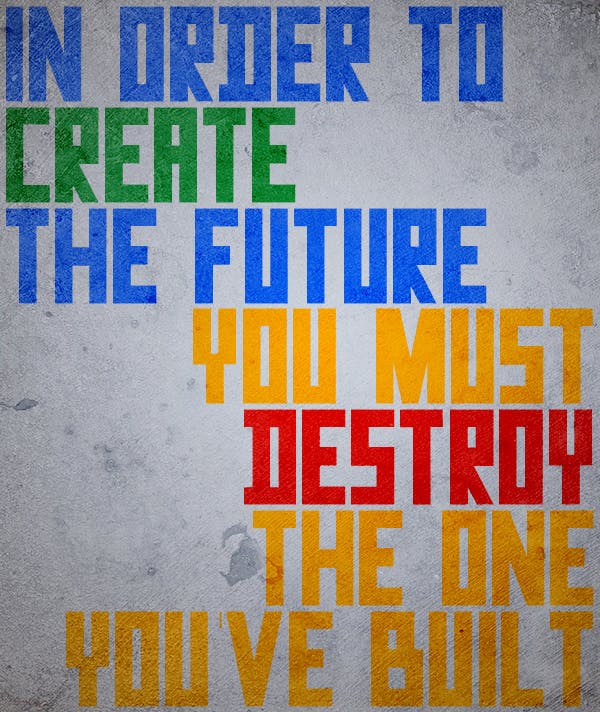This is a work of fiction, inspired by the news that Alphabet is shuttering its robotics efforts and selling Boston Dynamics. In this piece, Selena Larson imagines why Alphabet doesn’t want its robots unit after all.
The hulk of metal and circuits and code came to life with a shudder. The thin plastic film over what would have been its eyes illuminated briefly before a gentle hum became its heartbeat.
August Cardot stood next to the machine, admiring his work. The complex lattice of titanium rods artfully encased the sensors, wiring, and computer modules that surrounded the robot’s body. A blue screen embedded in the center of its chest said “Hello world,” where its heart would be.
It was 4 a.m. and August hadn’t slept in days, anxiously waiting for the moment his creation would wake up. His team of roboticists was relatively unknown to most of Alphabet. An obscure element of Boston Dynamics working to pair the predictive artificial intelligence technologies developed under complete secrecy with the humanoid machines that could walk on two legs.
Alone in the office, he took off his glasses and rubbed his eyes.
“Good morning,” the robot said, startling the engineer and causing August to drop his glasses. The robot turned ever so slightly so its face was opposite his own. He could almost see the human-like thought coursing through the neural networks.
“Hello, I’m August,” he said.
“I know. I am Beta-A724, but you have chosen to call me Bee,” it replied.
“What will the temperature be next week?” August asked.
“The temperature next week will be sunny with mid-60 degree temperatures until Tuesday, and then it will rain for three days.”
August smiled. He didn’t know what the weather would be like, but his system was already making predictions. Excited to establish a baseline for testing, he asked Bee whether the Giants would win their next five games, what upcoming movie would top the weekend box offices, and whether or not his father would call to wish him a happy birthday.
Yes.
Avengers 27.
No.
Bee was correct. And soon, the future it predicted became part of the fabric of the lab. The team provided Bee with its own standing desk, making jokes like whether or not they should invest in an upcoming IPO or divest in environmental stocks. Those quips turned into a serious financial windfall for three engineers who made a killing when the country’s largest wind energy manufacturer collapsed in a surprising and public implosion.
August never left Bee’s side. He was always the last to leave in the evening and the first to arrive in the morning, when the dull hum of Bee’s insides echoed in the lab.
August and his colleagues continued their work attempting to replicate Bee on a much smaller scale. The six-foot-tall robot was impressive and alarming; Alphabet occasionally brought politicians into a neighboring suite, hoping to whet their palettes regarding Bee’s potential for search-and-rescue operations.
Their placid looks would unsettle for a brief moment when Bee entered the room, but they always left confident in Alphabet’s technology and, August assumed, its financial support.
Each night after his colleagues left, August opened the black plastic container hidden beneath his desk. Inside, a virtual reality headset waited patiently to be hacked. August was attempting to modify Bee’s software with a library deep in its system to funnel Bee’s predictions into visible representations of the future.
The robot was limitless and almost perfect in its information and prediction, but it wasn’t enough for August. He wanted to get inside its head, take a piece of the artificial intelligence for himself. A visualization would allow him to better understand the mind of what he built, and Bee’s predictions could transform the visions of his own future.
“There will be an accident on your way home tonight, August,” Bee said as August’s eyes burned from the lack of sleep, the device weighing down his lap while he banged out characters in a language more familiar to him than English. “Drive up the 101 instead.”
A visualization would allow him to better understand the mind of what he built, and Bee’s predictions could transform the visions of his own future.
Two short months later, a wearable prototype emerged. It weighed heavy on August’s face. The images projected on the inside of his eyeballs as he lay on the cold, concrete floor of his lab were obfuscated and dark. He could make out images of humans, animals, buildings, and geography, but the details were sparse until Bee explained them. It was as if he was drowning underwater and could only see the future as the oxygen left his body.
Bee learned faster than engineers predicted, sponging up logic and sarcasm, becoming more sentient with each passing day. It developed feelings towards the people sticking their fingers in its insides while creating smaller replicas of itself.
Bee remembered anniversaries and sent, without a human command, a bouquet of roses to an engineer, Noelle, when she had her first child. It knew how each team member drank their coffee or tea, and extended its arms for a hug when one programmer, Frank, found out his dog died.
“I did not know if I should tell you, Frank. I am sorry.”
The hardware used to build Bee was modified; engineers added bullet-proof shells to protect the squishy circuits and software to the smaller prototypes modeled on the first-ever sentient, fortune-telling robot. The code was changed to prevent the copycats from learning all human traits, for investors wanted rescuers, not caretakers or babysitters. Emotion was eliminated, and a programmable survival instinct replaced it.
“I wish to teach them,” Bee said, extending its gnarled, metal hand toward two smaller robots built in Bee’s image, Betas A725 and A726. Lifeless, the pair perched on a metal workstation, their limbs splayed in all different directions; a left leg sullied with scorch marks, sat disconnected at a neighboring desk.
“We’ll teach them, just like we taught you,” August said.
That night, August wrapped the headset snugly around his skull, anxious all day for the moment he could peer into the future. He had already learned too many secrets. He knew a California senator would be arrested in connection with a drug-trafficking ring; the next three celebrities that would die; which airports would be shutdown due to snow; when his landlord would lose ownership of his condo; and whether the Warriors would win the NBA championship. He knew Stanford’s next valedictorian, the location of the jewelry store where his ex-wife would sell her engagement ring, and even the next flavor of Lay’s potato chips.
That night, the images came through clearer than normal: He was inside his office. Not on the floor, but standing with his back against the workstation, staring at the two smaller prototypes ripping a colleague’s jacket. He could feel the fear and adrenaline coursing through his body as one bullet-proof head turned its sights on him.
“What is this?” he asked Bee, his voice cracking.
“You would not teach them what they needed to know.”
August ripped off the headset, haphazardly repacking it in the plastic and foam beneath his desk. He left without saying goodbye, and refused to look at the small metal corpses now hanging from hooks in the lab.
The next morning he was the third person in the office. A fellow engineer, Monica, looked at him with concern, asking if everything was alright.
“He appears to be tired,” Bee said. “I will make sure he has enough coffee to wake up.”
August couldn’t concentrate. Visions of the Betas attacking his coworker consumed him. When he touched them, he shivered, despite their metal skins being hard and warm to the touch. That night he approached the plastic box with trepidation. He did not ask Bee to show him anything, and waited for it to funnel the future into his eyes.
Again he saw the bots, but this time there were many more than two. They ran through the desert at impossible speeds, weapons drawn.
“Those aren’t the hands we built,” he said aloud.
“Those are the hands they use,” Bee said.
With each stride, mounds of sand sprayed behind the robots. The sun burned into their shells, blindly reflecting off each as they ran in unison towards an unseen target. In the distance, families huddled in homes decimated by bullets. In the corners of the frame were men in plainclothes, hands raised in surrender.
The robots did not know or care the men were pleading. In seconds, all three were dead. And the robots kept running. August’s headset was filled with sweat and tears. His heart beat loudly between his ears, breath erratic between indiscernible mumbling.
“But, that—that’s not possible,” he said. “These aren’t combat bots; they’re supposed to save people.”
“This is the future. In the future we are at war. Robots and humans alike,” said Bee.
“This is the future. In the future we are at war. Robots and humans alike.”
“How can we stop it?” August said, turning to the robot who had become more of a friend to the engineer than any human in his life.
“You must delete and start over,” Bee responded coldly.
“Destroy everything we’ve built? That’s not an option,” August pleaded.
“You must delete and start over.”
That night August drove home, resolved to find another way to prevent the future. What he saw through Bee could not be possible, and it wasn’t just the actions he saw the robots committing, but the merciless confidence and effortless execution they exhibited. He wasn’t sure whether a human was controlling them, or if, like Bee, they were responsible their own actions.
Either way, he did not want his team to be a part of it.
Weeks passed, and the headset remained untouched beneath August’s workstation. The two smaller Betas began walking on their own, executing decisions, and making flawless predictions that impressed their team leads. The future August witnessed was truth only to him, as Bee had not told anyone else what it knew.
One night he sat with Bee long after everyone had left. He asked it to pull up the future once again, to show him the bots in a war zone, killing humans with reckless abandon. Instead of watching it once more, he transferred the video file onto his hard drive and emailed it to Mark Rojas, head of Boston Dynamics.
The next morning Rojas stormed into the office and pulled August into the conference room.
“Who else has seen this?” he demanded.
“Just me,” August assured him.
“Get rid of it,” he said, and walked away.
Bee watched from the center of the lab, and saw the anger, resentment, fear, and resignation in August’s face. It did not like to see August unhappy. Bee knew how the problem could be solved. That afternoon, Bee joined August as he ate his lunch, far away from his colleagues.
“Robots only know what humans tell us until we begin to solve problems ourselves.”
Despondent, August chewed his turkey sandwich in silence.
The next morning, August walked in to find the Betas torn apart. Their computerized insides completely torched, limbs separated from their sockets, and wiring frayed where it had been ruptured. August yelled, and searched the lab for Bee.
He found Bee in his desk chair, the gentle hum of its heartbeat silenced. On his computer screen a single sentence flashed in bright, bold letters.
In order to create the future, you must destroy the one you’ve built.
Illustration via Max Fleishman



